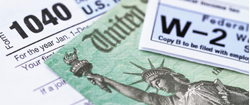The information in this article is up to date for tax year 2025 (returns filed in 2026).
If you’re self-employed, a freelancer, or earning income without tax withholding, making estimated tax payments is crucial to avoid IRS penalties. But figuring out when to pay and how much can be confusing. Whether you’re paying quarterly taxes for the first time or need a refresher, ezTaxReturn’s got you covered. This article will guide you through who needs to pay, key dates, calculation methods, and the potential consequences of missing a payment.
Key Takeaways
- Estimated tax payments are necessary for income not subject to withholding, including self-employment earnings and investment income.
- If you expect to owe $1,000 or more, you need to make quarterly estimated payments to avoid penalties.
- Use either last year’s taxes or annualize your income to calculate estimated payments, and remember to adjust payments as your income fluctuates.
What Are Estimated Tax Payments?
Estimated tax payments are periodic payments made to the IRS (and sometimes state tax agencies) for income not subject to withholding. Essentially, if you earn money without automatic tax deductions, you are required to pay estimated taxes on that income.
These payments also help cover additional tax obligations like self-employment tax and the alternative minimum tax. If you’re a W-2 employee whose withholding doesn’t cover your entire tax bill, you might need to make estimated payments as well. The key is to pay taxes as you earn income to avoid a large tax bill at the end of the year.
Who Needs to Make Estimated Tax Payments?
If you expect to owe $1,000 or more when you file your income tax return, you generally need to make estimated tax payments. This includes those who earn other income from interest, dividends, alimony, self-employment, capital gains, prizes, and awards.
Self-employed individuals, business owners, and those with significant non-withheld income are the primary groups required to pay taxes quarterly. Certain household employers who might need to cover taxes for household employees should also consider making payments.
Essentially, if you expect to owe a significant amount, it’s better to make estimated payments and avoid penalties.
Key Dates for Estimated Tax Payments
Quarterly payments are due throughout the year, with each payment period clearly defined for the tax year. For 2025, the deadlines are as follows:
- First quarterly payment: April 15
- Second quarterly payment: June 16
- Third quarterly payment: September 15
- Final payment for the year: January 15, 2026
These deadlines are crucial because missing them can lead to penalties and interest on the amount owed. Mark your calendar and set reminders to ensure you don’t miss any of these important dates. Staying on top of these deadlines will help you manage your tax liability throughout the year.
How to Calculate Your Estimated Tax Payments
Calculating your estimated tax payments can be done using two main methods: using last year’s taxes or annualizing your income for the current year. Both methods have their advantages and can help you avoid underpayment penalties.
Using Last Year’s Taxes
One of the simplest ways to estimate your tax payments is to use last year’s tax return. Estimate the total tax owed from last year’s return and divide it into four equal installments. This method is particularly useful if your income and deductions are relatively stable year over year.
If your earnings differ greatly from your estimates, you have the option to complete another Form 1040-ES. This will allow you to refigure your estimated tax for the upcoming quarter. This ensures that you’re always paying the right amount and helps avoid any surprises at the end of the year.
Annualizing Income
For those with variable income, annualizing your income can provide a more accurate estimate of what you owe in taxes. This method involves projecting your income for the entire year and making payments based on these projections.
Annualizing your income is particularly beneficial for individuals whose earnings fluctuate significantly throughout the year. It allows you to make unequal payments that align more closely with your actual income, thereby reducing the risk of underpayment penalties.
Methods to Pay Your Estimated Taxes
There are several methods to pay your estimated taxes, making it easy to choose one that suits your preferences. The IRS provides a Direct Pay option that allows you to make instant payments directly from your bank account without any fees.
You can also use the IRS2Go mobile device app, pay via credit or debit cards, or send checks or money orders to the IRS. For those who prefer cash, payments can be made at designated retail locations using a barcode generated by authorized payment processors.
If electronic payments aren’t your thing, there are plenty of other options to ensure you stay compliant.
What Happens If You Don’t Pay Estimated Taxes?
Failing to make estimated tax payments can lead to penalties and interest. The IRS calculates the underpayment penalty based on the amount owed and the duration of the underpayment. Avoid these penalties by ensuring your total tax owed is under $1,000 or that you’ve paid at least 90% of your current year tax bill.
Missing a quarterly payment can lead to penalties and interest that accumulate until the amount is fully paid. However, serious personal circumstances, such as illness or unexpected disasters, might qualify you for a penalty waiver.
Understanding the risks and taking steps to avoid these costly penalties is crucial.
Strategies to Simplify Estimated Tax Payments
Paying estimated taxes doesn’t have to be a headache. With the right strategies, you can stay compliant with the IRS and avoid penalties—without stress. Here are some smart ways to simplify the process:
1. Use the IRS Safe Harbor Rule
If you’re unsure how much to pay, following the IRS Safe Harbor rule can help you avoid underpayment penalties. In general, pay 100% of last year’s tax liability (or 110% if your income exceeded $150,000). This method offers peace of mind, especially when your income fluctuates.
2. Automate Quarterly Reminders
Set calendar alerts to remind you of upcoming estimated tax due dates—typically April, June, September, and January. ezTaxReturn users can also sign up for timely email reminders so you never miss a deadline.
3. Divide and Conquer
Instead of scrambling to come up with a large payment every quarter, break it down into monthly or bi-weekly savings. Set up a separate bank account and automatically transfer funds based on your estimated tax amount.
4. Adjust Withholding if You Have a Job
If you have a part-time or full-time job in addition to freelance or side income, increasing your W-4 withholding can reduce or even eliminate your estimated tax payments. For married couples, if one spouse has sufficient taxes withheld, it might cover the tax liability for both, simplifying the management of estimated tax payments.
5. Keep Accurate Records All Year
Stay organized with your income and expenses so you can easily estimate your tax liability each quarter. Use a spreadsheet, bookkeeping software, or even a simple income tracker to monitor earnings from gig work, self-employment, or investments.
Special Considerations for Certain Taxpayers
Certain taxpayers might have unique situations that require adjustments to their estimated tax payments. Life changes such as relocation, job loss, or changes in marital status can significantly impact your tax obligations.
Stay aware of these changes and adjust your payments accordingly to avoid any unexpected tax liabilities.
Adjusting Your Estimated Tax Payments Throughout the Year
Income can fluctuate throughout the year, making it necessary to adjust your estimated tax payments. If you expect your income this year to be higher than last year, make sure to cover 100% of your current year income tax liability. Conversely, if you expect lower income, paying at least 90% of your current year’s tax bill can help you avoid penalties.
For those with variable incomes, it’s advisable to estimate your tax bill at the end of each quarter based on actual income and deductions. This method helps ensure that your payments are accurate and timely, minimizing the risk of underpayment penalties. Setting up calendar reminders for due dates can also help keep you on track.
Summary
In summary, understanding and managing estimated tax payments is crucial for anyone with non-withheld income. By keeping track of key dates, calculating your payments accurately, and staying aware of potential penalties, you can ensure smooth sailing through tax season.
Frequently Asked Questions
Who needs to make estimated tax payments?
You need to make estimated tax payments if you think you’ll owe $1,000 or more when you file your return. It’s a good way to avoid any surprises come tax time!
What are the key dates for making estimated tax payments?
You’ll want to mark these key dates for estimated tax payments: April 15, June 16, September 15, and then January 15 of the following year. Staying on top of these will help you avoid penalties.
How can I calculate my estimated tax payments?
The easiest way to figure out your estimated tax payments is by using last year’s tax info or by estimating your current year income. Just keep it simple and adjust as needed.
What happens if I don’t make estimated tax payments?
Not making estimated tax payments can lead to penalties and interest piling up on what you owe, based on how long you’ve underpaid. It’s definitely wise to stay on top of those payments to avoid extra costs!
Are there any strategies to simplify estimated tax payments?
You can totally make your estimated tax payments easier by adjusting your withholding using Form W-4 or just splitting your tax liability into four equal payments. It keeps things simple and stress-free!
The articles and content published on this blog are provided for informational purposes only. The information presented is not intended to be, and should not be taken as, legal, financial, or professional advice. Readers are advised to seek appropriate professional guidance and conduct their own due diligence before making any decisions based on the information provided.




